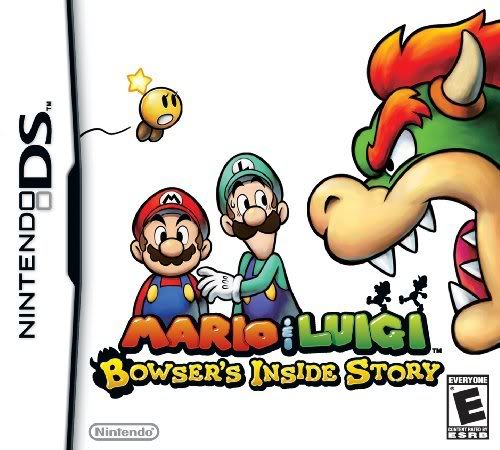
Let’s Begin With A History Lesson
People who played video games during the 16-bit era may remember a title that resulted from an all-star collaboration between two powerhouse developers: Square and Nintendo. This title, known as Mario RPG, was loved by many due to the action and humor it brought to the RPG genre. Battles were no longer simple turn-based affairs where you sifted through endless menus. Instead, you played an active role in the battles.
Timed attacks were an essential ingredient of Mario RPG’s gameplay. Even though your characters still took turns with enemies, you could actually influence how effective your characters’ attacks were by pressing buttons at the correct time. For example, say it was Mario’s turn. To attack with his gloves, you’d press the A button. Once his attack actually commenced, you could press A again right before the blow struck the enemy to throw another punch and do double the damage. This kind of timing also applied to special moves.

If Mario wanted to perform a special move called “Super Jump,” he could press Y to initiate the attack. Then, he could follow up by pressing Y when making contact with the enemy to perform a second jump. The player could do this as many times as physically possible to perform a seemingly endless series of jumps.
Square’s Mario RPG was the originator of timed hits, but after they had a falling out with Nintendo, the house of Mario decided to produce an RPG of their own for the Nintendo 64. This title originally began as Mario RPG 2, but the title was changed to Paper Mario part way through the development process. It too used timed attacks, but some gamers felt that Paper Mario’s battle system felt like a dumbed down Mario RPG experience. Their negative reaction was probably due to the enormous buttons that would appear on-screen before attacks, and the limited options available for dodging opponents’ strikes.
Well, these complaints obviously reached Nintendo, because they decided to have one of their development teams: AlphaDream, work on a new project. This project mired in secrecy would come to be known as Mario & Luigi. It was later released for the RPG-starved Game Boy Advance. Mario & Luigi didn’t sell as well as Nintendo anticipated, but it still met with critical acclaim, and became well-regarded by Mario RPG fans.
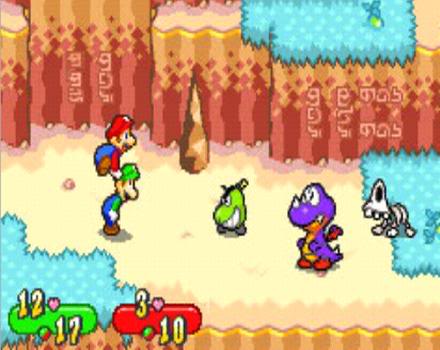
One of the reasons it was met with such positive reception despite its relatively unknown status was because it made some significant expansions to the Mario RPG formula. Paper Mario had witty dialogue and timed hits, but Mario & Luigi took it a step further. AlphaDream (and localization team Treehouse) peppered the script with gut-busting dialogue that could elicit laughs out of a drill sergeant. Equally amazing, was that Mario and Luigi’s on-screen antics provided for just as many laughs. Anyone who played Mario RPG remembers Mario and crew acting out events on-screen, and they likely recognized even more of this in its spiritual sequel.
Mario & Luigi was also well-regarded for its battle system that involved timed button presses and gave players the ability to dodge any incoming attack. This time, players could only control Mario and Luigi, but with so many attacks and such precise control, this mattered little. Mario & Luigi’s battle system was successful because it mixed the statistics and character customization of RPGs with quick reflexes players would normally utilize in a platformer.
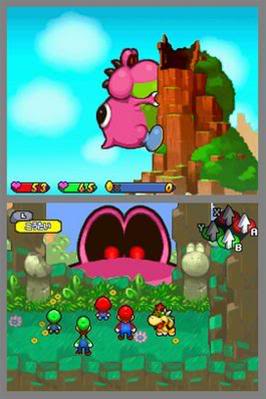
Unfortunately, Mario & Luigi’s humorous dialogue and excellent timing-based battle system weren’t enough to keep the game from fading into obscurity. Still, Mario & Luigi fans were fortunate enough to get two more games in the series for the Nintendo DS. Read on to find a full review of the most recent game in the series.
Mario & Luigi: Bowser’s Inside Story Review
Ah…September 15, 2009. Mario & Luigi: Bowser’s Inside Story had finally arrived. I’m not going to lie–this is the game I was anticipating the most this year. Yes, more than titles like Uncharted 2 and Modern Warfare 2 (and no, I don’t have something against games with a two in the title). Part of what drew me to Bowser’s Inside Story was my love for Mario RPG and its spiritual successors: Mario & Luigi: Super Star Saga and Partners In Time. I loved the humor and timed hits of the previous Mario & Luigi titles, so I couldn’t wait for a third.
Still, I have to admit that I was feeling a bit uneasy prior to the release of Bowser’s Inside Story. Mario & Luigi 2 didn’t innovate nearly as much as its predecessor, so I was a bit worried that the gameplay could have grown stale. Fortunately, my fears were quickly put to rest.
Bowser’s Inside Story keeps the series’ charm intact, while introducing several important gameplay enhancements. Even though Mario & Luigi 2’s core gameplay was solid, I welcomed the additions introduced in Bowser’s Inside Story with open arms.
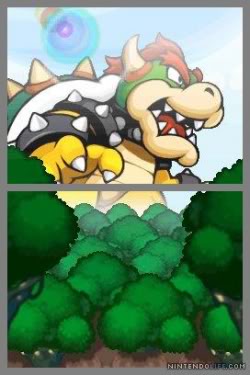
The first of these gameplay changes is the introduction of a character that hasn’t been a part of turn-based battles since Super Mario RPG. The King of the Koopas had been missing in action for far too long, so AlphaDream wisely decided to include him in the latest Mario & Luigi.
If you played the two most recent Paper Mario titles, you might wonder what the lumbering beast named Bowser could bring to the gameplay. I mean, he did breath fire, but that didn’t change the fact that he moved slower than a metropolitan traffic jam. Thankfully, Bowser has a larger skill-set this time and plays an integral role in the Mario & Luigi experience.
He’s still less limber than Mario (as he should be), but there’s nothing like stomping around as the boss of all bosses. When using Bowser, it’s always evident that he’s a force to be reckoned with, because he fills a considerable portion of the screen. He may move a little slow, but while walking on the field, Bowser can smash objects with his giant claws, dash, and breath fire, in addition to some new moves (one inspired by an ability from the Metroid titles).
As Mario and Luigi could in their previous titles, Bowser can initiate battles by running into an enemy, or he can get the drop on foes by attacking them before battle. If Bowser is successful, he’ll be the first to attack once he enters a battle.
Regardless of what occurs before battle, the experience will still play out the same. The player will select Bowser’s attacks by pressing the X and Y buttons. Bowser can perform two basic types of timed attacks with these two buttons. Pressing the X button will cause the Koopa King to wind up for a devastating punch. The power of your punch will ultimately depend on when you press the button a second time. Before using Bowser’s moves for the first time, there are tutorials for you to practice your timing, so you’ll be squashing plumbers in no time.
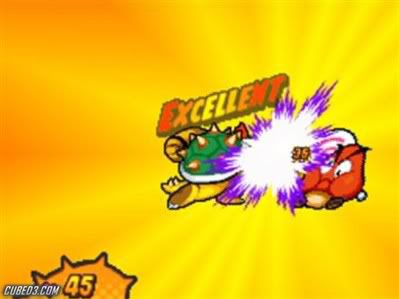
Besides Bowser’s power-packin’ punch that’d make Mike Tyson jealous, he can also spew flames. As with his punch, Bowser simply has to charge up, and the player needs to press Y a second time to strike all enemies with this mad koopa’s fiery breath. Sometimes, these flames will do more than damage enemies–they might even neutralize a foe’s special abilities. For example, Bowser can roast the petals off a venomous flower.
Early in his adventure, Bowser will also learn to inhale foes by rapidly tapping X. This is useful for sucking up hidden blocks found in each area that can be traded in for items, and is also handy when fighting smaller foes. When smaller foes are swallowed, they’ll enter Bowser’s belly where they’ll find themselves toe to toe with two mustachioed plumbers, but I’ll get to that in a moment.
Bowser can also use a number of special abilities that he’ll learn throughout his adventure. As the Koopa King traverses new areas, he’ll encounter various captured minions that will provide him with new abilities.
For example, when Bowser rescues a regiment of goombas, they’ll aid him in battle as a special ability. Bowser simply has to highlight the goomba attack, then he’ll use SP (Special Points) to initiate a goomba charge. The angry koopa will fire up his little allies by touching them with the stylus as they charge towards his enemies. This will set them aflame–and they’ll assault the enemy from above.
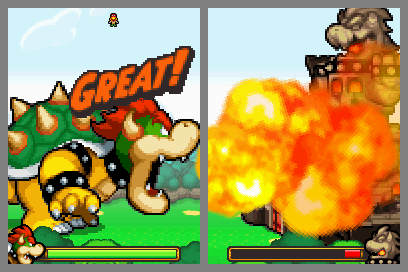
Other special abilities will have you using the stylus in different ways: you’ll ricochet koopa shells by guiding Bowser’s giant shell, you’ll line up a set of explosive allies, and you’ll scrub another ally clean. These attacks are fun to perform, and can pack quite a punch.
Bowser has several abilities he can learn, but he’s only one part of the experience. The Mario Brothers make up the other portion of Mario & Luigi 3.
Towards the beginning of Bowser’s Inside Story, the famous overall sportin’ plumber duo are swallowed by the big brute himself. As a result, they’ll rarely see the light of day. Still, players will spend at least as much time with them as they will with Bowser.
Despite being inside Bower’s enormous frame, the beloved Italian plumbers will be forced into numerous battle situations. Thankfully, they control just as well as in the previous two Mario & Luigi titles.
As in their two previous adventures, Mario is controlled with A and Luigi is controlled with B. With each character, the player can choose between jump attacks, hammer attacks, special abilities, items, and fleeing. All of these abilities are quite useful, and that’s a good thing, as you’ll be using them frequently.
One of the brother’s most powerful regular attacks is “Jump,” but it’s also one of the most tricky to execute. The reason that it’s initially difficult to execute is because “Jump” involves two timed presses. Before making contact with the enemy, you have to press A or B (depending on your character), and if you timed it right, your character will launch into the air again where you’ll make another timed press before hitting the enemy for more damage. This sounds tricky, but you’ll get the hang of it quickly, as there are word indicators that let you know if you’re performing the moves correctly.
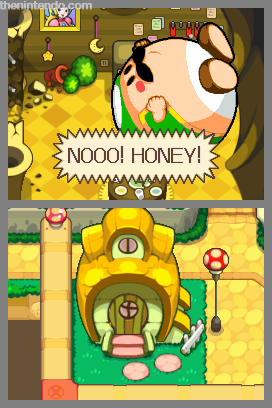
Jumping is useful in many situations, but you’ll also want to have your hammer at the ready. When battling spiky foes, you’ll damage your delicate toes, so it’s better to take your giant mallet out of your pocket and slam your opponent over the head. To give him a splitting headache, you simply have to hold the hammer button down and release when your character’s energy has peaked. This may sound simple, but it’s important to note that you can’t hold the button down too long. If you forget to let go, your hammer head will fly off, which will render your attack useless. Once again, this can be avoided with practice.
When foes are taking forever to defeat, you’ll want to drop your hammer and use a special ability. Mario & Luigi learn various special moves throughout the game by finding attack pieces hidden in each area. Many of the game’s areas have item blocks (both hidden and visible) that contain these pieces. Once you’ve found the ten pieces of an area, you’ll learn powerful abilities that are essential when fighting bosses.
These special abilities are executed in a variety of ways, and many of them have spectacular results. One of the first abilities you’ll learn has the Mario Brothers kicking shells into enemies repeatedly until they miss. This is done by pressing A when a shell hits Mario and pressing B when a shell comes into contact with Luigi. Over time, the shell will pick up speed, so the player has to have quick reflexes to perform a maximum amount of damage.
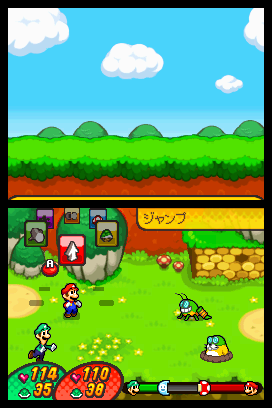
This ability was found in the other Mario & Luigi titles, but there are plenty of new creative abilities to be found. One has you moving Luigi with the directional pad under food falling from the top screen. Once you’ve consumed as much food as is humanly possible, Luigi will balloon into a giant, and it’s Mario’s job to hoist him up by rapidly tapping A. After this is accomplished, Mario will launch Luigi into the air where you have to press B at the height of your jump to smash your foes when gravity kicks in.
Special abilities help in keeping Mario & Luigi’s gameplay from growing stale, but even more important is its characters’ defensive maneuvers. Mario, Luigi, and Bowser all have defensive moves that will keep your thumbs attached to the buttons. One of the things that makes the Mario & Luigi series special is that you have the ability to dodge any attack if you’re skilled enough.
Say you’re fighting a Monty Mole. The mole can come at you by popping out of a hole directly in front of one of your characters. If you react quickly enough with the character he attacks, you can conk him on the head with a hammer, while avoiding being damaged at the same time. The mole also can choose to drill underneath your character. You’ll have to launch into the air at the appropriate time and then jump with your next character as the mole passes under your adjacent ally. The Monty Mole also has a number of other attacks such as launching boulders that you’ll need to jump over or remain stationary, depending on the elevation of the object he throws.
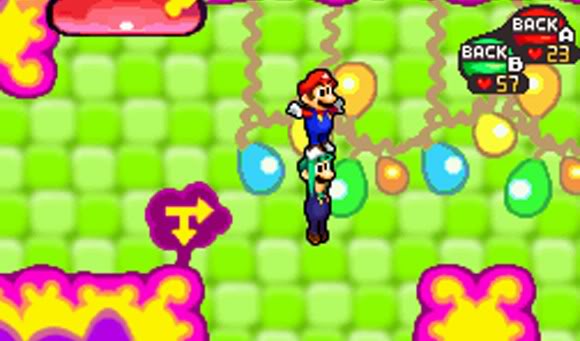
Every enemy and boss you encounter in the game has various attacks, so it’s important to pay attention to their animations to determine what move they’ll use. If you’re a skillful player, you’ll probably dodge attacks more often than not, but if you’re not so skilled, it’s important to bring loads of items. This applies for Bowser as well.
Bowser can also dodge attacks by curling up in his spiky shell, or he can punch whatever is coming towards him. You’ll never grow tired of fighting enemies, because each type of enemy you’ll encounter has different attacks, so you’ll always be dodging opponents in different ways.
Before concluding my discussion of the battle system, it’s important to note that Bowser’s Inside Story brings a new type of battle to the Mario & Luigi series. At certain points in the story, you’ll encounter screen filling bosses, and Bowser will transform to match their size. When this occurs, you’ll turn the DS vertically and execute new types of commands. These battles are still turn-based, but moves are executed with the stylus and through voice recognition.
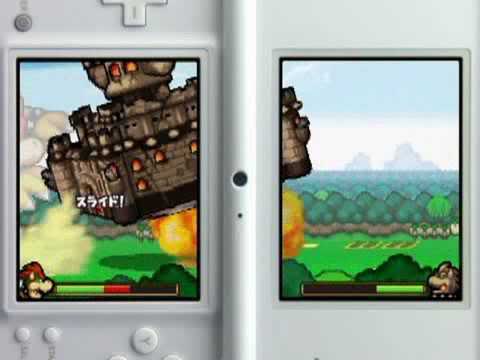
In these Godzilla inspired brawls, players will punch their opponent by sliding their stylus from left to right quickly. If they’re successful, they’ll usually cause damage to their opponent and knock him back. Players can also flame broil their opponent by blowing into the mic. You’ll probably look silly doing it in public, but it’s actually quite fun.
Besides these commands, you’ll perform various defensive maneuvers such as shooting down incoming projectiles. These battles are a nice change of pace, and definitely match Bowser’s large-and-in-charge persona.
Clearly, the battle system is an integral component of Bowser’s Inside Story, but it’s important not to forget one of the game’s other essential ingredients–excellent dialogue delivered via a superb localization. Rarely will you find a game that has the humor of Bowser’s Inside Story.
To begin, the story is mostly nonsensical, but it’s actually quite comical. The villain from the first Mario & Luigi, Fawful, infects the Mushroom Kingdom with a virus called the blorbs that turns the toads into blimp-sized mushrooms. With the Mushroom Kingdom in turmoil, the princess calls for an emergency meeting.
Of course Mario & Luigi show up, but the assembly is interrupted by Bowser who earlier inhaled a mushroom provided to him by Fawful. As usual, Bowser had planned on kidnapping the princess, but Fawful’s mushroom caused Bowser to inhale everyone in the meeting room.
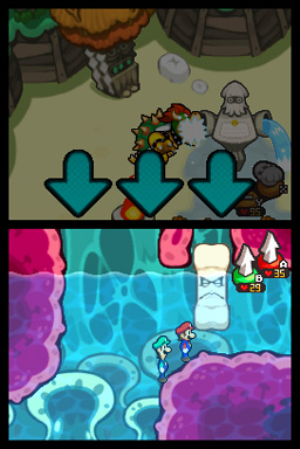
With Fawful’s plan a success, he expelled Bowser from the kingdom. Bowser then made it his mission to retrieve Peach (who he didn’t realize was in his belly) and his castle.
Obviously, this comical story isn’t meant to be taken seriously. Instead of being a typical melodramatic RPG story, Bowser’s Inside Story tells its tale through humor and interesting dialogue. Each character has a well-developed personality, and a unique manner of speech. For example, Bowser sounds like an arrogant, bumbling idiot, while Fawful communicates in nerd-speak. You’ll encounter many other flavorful characters such as a talking block that speaks in a French accent. The writing is all top-notch, so you’ll never dread starting a conversation.
In a video game, good writing can only take you so far however, so it’s important to briefly mention the visual and auditory experience. As with all Mario & Luigi games, the visuals are bright and saturated with color. They aren’t 3D, but the large, well-animated character sprites play an important role in revealing the characters’ personalities. Dialogue is useful when identifying characters, but it can only do so much. We wouldn’t really know how much of a coward Luigi is without him quaking in fear behind a non-combatant. Likewise, we wouldn’t see Mario and Luigi’s playful nature without their fake-Italian banter and physical gestures.
Bowser’s Inside Story’s environments are also visually pleasing. Everything from Bowser’s disgusting insides to sandy beaches are quite detailed and make for fun gameplay moments. You’ll constantly switch between Bowser’s insides and the world around him for all sorts of interesting puzzles.
For example, say Bowser is trying to move a massive ship. Mario & Luigi would need to activate a particular region of his body by performing some sort of mini-game. If they successfully completed the mini-game, then Bowser would get a significant strength boost, which would enable him to move a large sea vessel. These mini-games are usually quite enjoyable, and typically involve timed button presses or the use of the stylus.
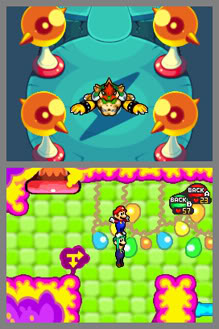
One mini-game will have you alternating between Mario and Luigi hitting energy balls at a target area with their hammers, while another will have you using the stylus to guide the brothers into objects jutting out of Bowser’s innards. These segments provide a nice change of pace from the puzzle solving and platforming found in the Mushroom Kingdom and inside Bowser.
The last aspect of Bowser’s Inside Story I’d like to mention is the wonderful music. Once again, Yoko Shimomura (of Legend of Mana, Mario RPG, and Kingdom Hearts fame), provides us with a soundtrack that perfectly mirrors the action occurring on-screen. From the epic final boss song to the upbeat tune playing in Dr. Toadly’s office, there’s not a dud in the bunch. If you enjoyed Yoko Shimomura’s previous works, you’ll probably enjoy her light-hearted compositions for Bowser’s Inside Story.
What’s great about Mario & Luigi: Bowser’s Inside Story is that it’s a game that anyone could enjoy. Whether you’re a fan of Mario, an RPG enthusiast, or love action games–Bowser’s Inside Story has something for you. Those who appreciate humor and well-written works would also do well to pick up this video game. Bowser’s Inside Story’s twenty-plus hours of gameplay provide an unparalleled amount of variety and very little filler content, so it’s a worthy purchase at thirty-five bucks. Even if you hate RPGs, you should give this game a shot. You may not appreciate the character customization options at first, but with the gameplay that requires precise timing and quick thinking, it’s likely that it’ll grow on you. Besides, the worst that could happen is that you’ll fall out of your chair laughing.
Score: 9.5
Pros:
- Few video games pack this kind of variety over twenty hours
- Includes a great musical score by Yoko Shimomura of Kingdom Hearts and Mario RPG fame
- Bright, colorful visuals bring Mario’s (and Bowser’s) world to life
- Well-animated characters and great sound effects provide for plenty of personality
- Humorous, well-written dialogue provides for a Fawfully good game
- Excellent battle system that is accessible, yet contains plenty of depth
- If you’re good enough, you can dodge (or counter) any attack!
- Bowser finally gets the spotlight
- Contains several enjoyable mini-games
Cons:
- Certain stylus moves are difficult to perform
- Bosses will work you if you don’t know their patterns
- Some players might have trouble understanding one character’s French accent
- I wish I could have spent more time outside of Bowser’s body with Mario and Luigi
- Sometimes attack pieces (which grant special abilities) are easy to miss
VentureBeat's mission is to be a digital town square for technical decision-makers to gain knowledge about transformative enterprise technology and transact. Learn More
